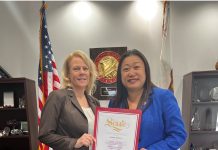Addressing the Chamber of Commerce’s annual State of the City lunch, Mayor Bob Whalen redefined the stated agenda Wednesday by describing not the status quo but the future.

Whalen outlined the five big issues he sees the city confronting: land use downtown and along Laguna Canyon Road, a parking master plan, a cultural arts plan, the undergrounding of utilities, and obtaining a secondary sustainable water source.
Describing land use efforts, Whalen highlighted the updating of the downtown specific plan now underway, noting the tremendous input from the community that has led to the upcoming trial closure of Forest Avenue. He also mentioned the review of development standards along Laguna Canyon Road, which he described as “a jewel” that captures the community’s essence. And he said the Laguna Canyon Road task force will likely report to the Council in August about the best ways to manage flooding and to improve safety for bikes and pedestrians. “Wouldn’t it be great to walk or bike out there safely?” he asked.
If open space defines the canyon, art defines Laguna’s soul, Whalen said, and called for reinvigorating Laguna’s art scene beyond the summer festivals, in a way that fills the city with people, not cars.
A common theme among the big issues is the transition from an auto-centric community to a more pedestrian and bike-oriented one, said Whalen. Beyond the already successful summer trolleys and new off-season service, will be the challenge to create a citywide parking master plan that investigates off-street structures in various neighborhoods, explores public-private joint ventures and seeks new opportunities to expand peripheral parking.
Undergrounding the utilities on Laguna Canyon Road is essential before any improvements can happen there, but it is equally important citywide, Whalen said. It’s a big, expensive undertaking, but the city must continue to analyze ways to make it happen, said Whalen.
“Water conservation is obviously the topic of the day,” said the mayor, noting that to comply with the state-mandated 25 percent reduction in use will likely involve cutting down outdoor watering.
Despite conservation, “the long range key is a secondary sustainable water source,” said Whalen. “We can conserve, but if the pipe goes dry, we’ve got a problem,” he said, urging exploration of potable reuse of the 10 million gallons per day spewing from the Aliso Creek outfall and supporting potential plans for a desalination plant in Dana Point.
The success of any effort will depend on gathering broad community input and winning public support for any development plan, concluded Whalen. For some of the larger projects “we will have to look at some kind of bond financing,” he said. “For the right project and the right mix, it’s something the community may support.”
As he wrapped up his speech, Whalen drew inspiration from Teddy Roosevelt, who said that if you believe you can do something, you’re halfway there.
“I believe we can. In my view, we are halfway there,” said Whalen. “I ask all of you to join us and move to the goal line.”





Smart reuse of wasted wastewater will provide Laguna Beach with local water reliability and increase fire protection throughout the drought. More recycled water also reduces sewage discharges only 1.2 miles offshore to protect the health of migrating grey whales, dolphins and us. Laguna Beach remains the only South OC city without a recycled water system. Let’s support the Mayor and City Council’s effort to responsibly improve local water resources with recycled water.